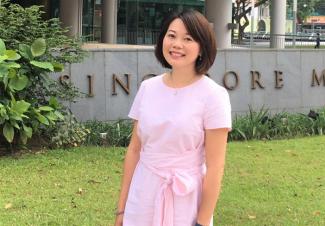
Accepting and appreciating contradictions are crucial to finding creative solutions, says SMU Associate Professor Angela Leung.
By Alvin Lee
SMU Office of Research & Tech Transfer – The Doctrine of the Mean, or 中庸, is a major tenet of Confucianism. In essence, it emphasises the importance of balance and harmony, moderating one’s emotions while shunning overt disagreement. Within East Asian cultures – Chinese, Japanese, Korean – this often extends into how interpersonal and societal matters are conducted, leading to a middle ground approach that avoids conflict in order to accommodate differing viewpoints.
Research by SMU Associate Professor of Psychology Angela Leung suggests that the approach could lead to less creativity when faced with a paradox.
“In a nutshell, paradoxes are contradictions,” Professor Leung tells the Office of Research and Tech Transfer, citing examples such as having to compete with others but at the same time collaborating with them. “Western cultures have a creative advantage after encountering paradox because people tend to resolve the conflict and come up with creative solutions,” referring to the Western practice of analytical thinking [to] reconcile conflict upfront.
Professor Leung draws further comparisons between Western cultures’ tendency to “integrate seemingly different ideas and generate higher order solutions” that resolve contradictions and East Asian cultures’ tendency to favour what is known as naïve dialectical thinking that harmonises contradictions instead of attempting to resolve them.
Paradox: The mother of creativity
In her 2018 research paper “Middle ground approach to paradox: Within- and between- culture examination of the creative benefits of paradoxical frames”, Professor Leung notes that paradoxical frames, or “mental templates that encourage individuals to recognise and embrace contradictions” could produce creative benefits. Indeed, her research concludes with the insight:
“Paradox is less beneficial to creativity when individuals are motivated to harmonise conflict and to compromise contradictory perspectives by finding a middle ground; paradox is more beneficial to creativity when individuals confront and scrutinise the conflict and search for integrative solutions that simultaneously fulfil competing elements.”
And in her recent work as a thesis supervisor, she explores with her student how adopting paradoxical frames can also help the modern working mother manage conflicting demands between obligations at home and at the workplace.
“For those who tend to take the middle ground approach, they may think of some solutions that are not the most optimal [such as] working part-time so that they can take care of the children, or they ask the employer to allow them to work at home,” she elaborates. “It still works, but these are only either-or solutions that do not allow women to simultaneously fulfil both career and motherhood goals; they still have to make some trade-off.”
Instead of choosing one over the other, and sometimes delaying having children or forgoing motherhood altogether, Professor Leung encourages women to reappraise and appreciate tension. Adopting a paradoxical mindset promotes the intention to pursue both career and motherhood, she adds, which might be even more beneficial career-wise than being focused solely on climbing the corporate ladder.
“There's some research showing that having children can [help] you work more efficiently or have a healthier life outlook that can benefit your career development,” Professor Leung says. “At the same time, being a parent can also help the children. Research suggests that children of working mothers can learn from a positive role model and they are more independent and flexible when they grow up.”
Globalised creativity
Professor Leung, who specialises in cultural and social psychology, also studies the psychological science of cosmopolitanism and globalisation. Her early research included one titled, “Do multicultural experiences make people more creative? If so, how?”, which examined how multicultural experiences can benefit the generation of creative ideas, such as Starbucks’ coffee mooncake and Lay’s Peking Duck flavoured potato chips.
Are people who have lived in multiple countries and experienced different cultures really more creative? Or are they just able to communicate better because of exposure to multiple ways of doing things?
“In one of my studies, I tried to expose participants to symbolic icons of different cultures, such as the American and Chinese cultures, with American icons like the blue jeans and hamburgers and Chinese icons like qipao (旗袍) and xiaolongbao (小笼包); this is considered a Multicultural Experience Induction group,” she explains. Participants in the control group, on the other hand, were exposed to icons from only one culture.
“I gave participants some ambiguous pictures with a caption depicting each picture and they had to come up with a new caption to describe the picture. Another task was to write down some gift ideas for a friend’s birthday. For those who were exposed to multiple cultural icons, they could think of captions that were very different from the given ones. They also came up with very creative gift ideas such as donating money in their friend’s name instead of common ideas such as gift vouchers or photo frames.”
She concludes, “Diversifying experiences such as immersion in two or more cultures or exposure to paradoxes can potentially broaden people’s creative bandwidth.”
Back to Research@SMU Nov 2019 Issue
Image credit: